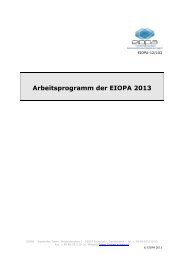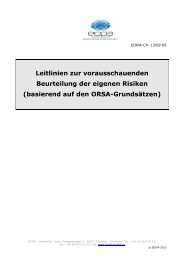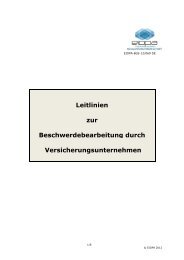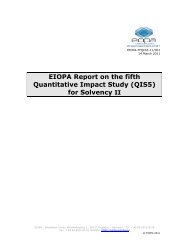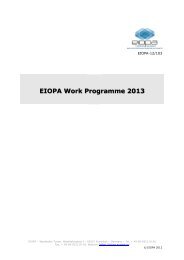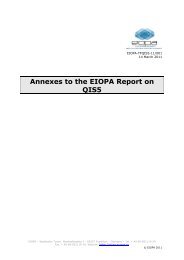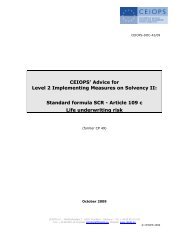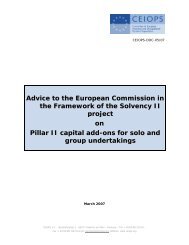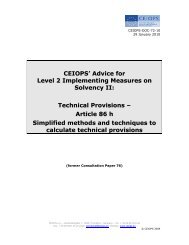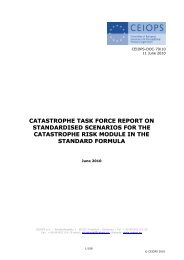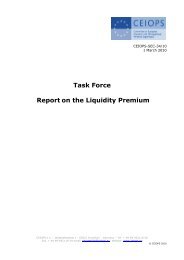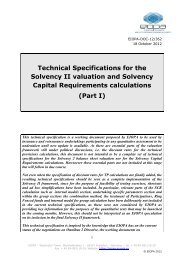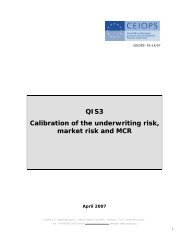Answers to the European Commission on the ... - Eiopa - Europa
Answers to the European Commission on the ... - Eiopa - Europa
Answers to the European Commission on the ... - Eiopa - Europa
Create successful ePaper yourself
Turn your PDF publications into a flip-book with our unique Google optimized e-Paper software.
9.15 Solvency II could also employ a dynamic approach: retaining <str<strong>on</strong>g>the</str<strong>on</strong>g><br />
existing requirements for a transiti<strong>on</strong>al period before adopting <strong>on</strong>e of<br />
<str<strong>on</strong>g>the</str<strong>on</strong>g> alternatives.<br />
- A formula based <strong>on</strong> <str<strong>on</strong>g>the</str<strong>on</strong>g> existing Solvency I<br />
9.16 A formula based <strong>on</strong> <str<strong>on</strong>g>the</str<strong>on</strong>g> existing requirement has <str<strong>on</strong>g>the</str<strong>on</strong>g> advantage of<br />
c<strong>on</strong>tinuity with <str<strong>on</strong>g>the</str<strong>on</strong>g> existing regime, which also reduces <str<strong>on</strong>g>the</str<strong>on</strong>g> risk of<br />
modelling error associated with <str<strong>on</strong>g>the</str<strong>on</strong>g> innovative and yet unproven SCR.<br />
Transiti<strong>on</strong>al costs for undertakings, as well as <str<strong>on</strong>g>the</str<strong>on</strong>g> expenses of<br />
developing and testing a formula would also be minimised.<br />
9.17 Against this, an MCR based <strong>on</strong> Solvency I would import <str<strong>on</strong>g>the</str<strong>on</strong>g><br />
disadvantages of <str<strong>on</strong>g>the</str<strong>on</strong>g> existing requirements in<str<strong>on</strong>g>to</str<strong>on</strong>g> Solvency II. It is<br />
difficult <str<strong>on</strong>g>to</str<strong>on</strong>g> identify an underlying <str<strong>on</strong>g>the</str<strong>on</strong>g>oretical basis for <str<strong>on</strong>g>the</str<strong>on</strong>g> present<br />
requirements, so it would also be difficult <str<strong>on</strong>g>to</str<strong>on</strong>g> dem<strong>on</strong>strate how <str<strong>on</strong>g>the</str<strong>on</strong>g> MCR<br />
achieved <str<strong>on</strong>g>the</str<strong>on</strong>g> purpose set out in CEIOPS’ working definiti<strong>on</strong>. Even if<br />
additi<strong>on</strong>al risk categories were added, <str<strong>on</strong>g>the</str<strong>on</strong>g>re would be a lack of<br />
c<strong>on</strong>sistency with <str<strong>on</strong>g>the</str<strong>on</strong>g> treatment of underwriting risk under <str<strong>on</strong>g>the</str<strong>on</strong>g> SCR.<br />
However, it may not be essential for <str<strong>on</strong>g>the</str<strong>on</strong>g> MCR <str<strong>on</strong>g>to</str<strong>on</strong>g> measure risks<br />
precisely in order <str<strong>on</strong>g>to</str<strong>on</strong>g> provide an effective safety net. Although <str<strong>on</strong>g>the</str<strong>on</strong>g><br />
<str<strong>on</strong>g>the</str<strong>on</strong>g>oretical basis of <str<strong>on</strong>g>the</str<strong>on</strong>g> current formula may have been forgotten,<br />
several working groups of supervisors have recognised that <str<strong>on</strong>g>the</str<strong>on</strong>g><br />
solvency margin worked well, at least as a safety net.<br />
9.18 Since <str<strong>on</strong>g>the</str<strong>on</strong>g> definiti<strong>on</strong> of <str<strong>on</strong>g>the</str<strong>on</strong>g> technical provisi<strong>on</strong>s is going <str<strong>on</strong>g>to</str<strong>on</strong>g> change (and,<br />
for some Member States, changes in asset valuati<strong>on</strong> will impact <str<strong>on</strong>g>the</str<strong>on</strong>g><br />
level of available capital), even when <str<strong>on</strong>g>the</str<strong>on</strong>g> existing Solvency I<br />
calculati<strong>on</strong>s are retained, <str<strong>on</strong>g>the</str<strong>on</strong>g> combined requirement of technical<br />
provisi<strong>on</strong>s plus <str<strong>on</strong>g>the</str<strong>on</strong>g> MCR is going <str<strong>on</strong>g>to</str<strong>on</strong>g> change. This also means that, even<br />
if <str<strong>on</strong>g>the</str<strong>on</strong>g> existing calculati<strong>on</strong>s are adopted, a review of <str<strong>on</strong>g>the</str<strong>on</strong>g> fac<str<strong>on</strong>g>to</str<strong>on</strong>g>rs via QIS<br />
will be necessary.<br />
9.19 Assuming that <str<strong>on</strong>g>the</str<strong>on</strong>g> existing formula is retained without major changes,<br />
<str<strong>on</strong>g>the</str<strong>on</strong>g> following adjustments need <str<strong>on</strong>g>to</str<strong>on</strong>g> be/might be c<strong>on</strong>sidered:<br />
• adjustments <str<strong>on</strong>g>to</str<strong>on</strong>g> ensure IASB compatibility;<br />
• adjustments aimed <str<strong>on</strong>g>to</str<strong>on</strong>g> correct minor anomalies without added<br />
complexity; and<br />
• shortcuts aiming for more simplicity, where this can be d<strong>on</strong>e<br />
without significant loss of risk sensitivity; c<strong>on</strong>sidering also that<br />
<str<strong>on</strong>g>the</str<strong>on</strong>g> SCR will be able <str<strong>on</strong>g>to</str<strong>on</strong>g> capture risks more elaborately.<br />
9.20 The use of some approximati<strong>on</strong>s could be allowed <str<strong>on</strong>g>to</str<strong>on</strong>g> facilitate interim<br />
calculati<strong>on</strong>s. However, if <str<strong>on</strong>g>the</str<strong>on</strong>g> existing formulae are retained for a<br />
transiti<strong>on</strong>al period <strong>on</strong>ly, it is suggested <str<strong>on</strong>g>to</str<strong>on</strong>g> keep adjustments <str<strong>on</strong>g>to</str<strong>on</strong>g> <str<strong>on</strong>g>the</str<strong>on</strong>g><br />
absolute minimum necessary, since marginal improvements would not<br />
justify <str<strong>on</strong>g>the</str<strong>on</strong>g> additi<strong>on</strong>al costs of a double reform.<br />
9.21 In its present form, <str<strong>on</strong>g>the</str<strong>on</strong>g> n<strong>on</strong>-life formula captures mainly underwriting<br />
risk. While <str<strong>on</strong>g>the</str<strong>on</strong>g> core formula uses balance sheet and profit-and-loss<br />
items, <str<strong>on</strong>g>the</str<strong>on</strong>g> differentiati<strong>on</strong> of <str<strong>on</strong>g>the</str<strong>on</strong>g> fac<str<strong>on</strong>g>to</str<strong>on</strong>g>rs according <str<strong>on</strong>g>to</str<strong>on</strong>g> business lines<br />
55



